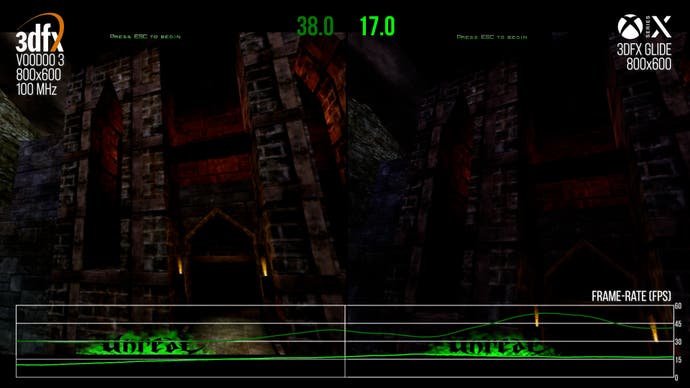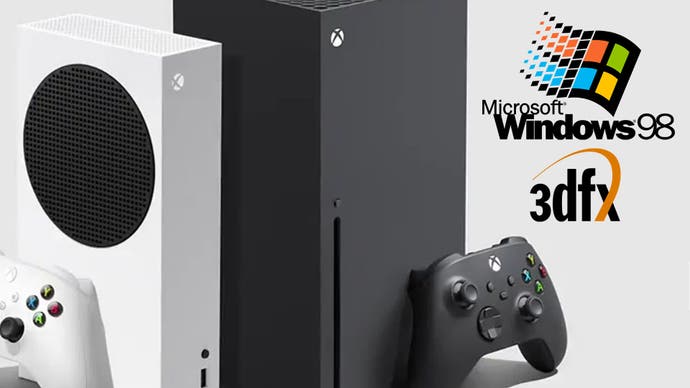I installed Windows 98 on Xbox Series X and played a range of classic PC games
Quake! Half-Life! Unreal! Command and Conquer!
The late 90s were many things - but for me, it was all about Pentium PCs and Windows 98. That being the case, I was delighted to learn that the DOSBox Pure RetroArch core had recently received support for the venerable OS, opening the door to a range of classic PC games that can now run on today's Microsoft console hardware. Quake, Half-Life, Turok: The Dinosaur Hunter, Command and Conquer... put simply, any Win98 game is now available to play on Xbox Series hardware and there's even emulated support for 3dfx Voodoo Graphics too.
Be prepared for a lot of installing, however, via a somewhat torturous procedure. That starts with an unusual workaround to get the RetroArch emulation system installed on Xbox, which in turn runs DOSBox Pure. I used this video guide to get going, without the need for developer mode. Once you have DOSBox Pure running on your Xbox console, you also need to - get this - install Windows 98 itself. It was a surreal moment to install this 20th century operating system on a vintage 2020 Microsoft console, but this must surely be the bright future that Bill Gates envisaged back in the day... but perhaps not in such a user-unfriendly manner. All software, including Win98 itself, has to be sourced and loaded via RetroArch's support for disc ISOs. I chose the FTP approach in beaming these ISOs across from my PC to my Xbox consoles - unfortunately, the more logical approach of the Xbox optical drive isn't possible.
Ultimately, what you end up with is a full Windows 98 OS install on your Xbox Series console, with games fully installed, meaning you can use it as you would any vintage PC - to the point where I wrote the script for the video embedded on this page using Microsoft Word running on my Series X, aided and abetted by a resurrected Clippy himself. From here on out then, things get simpler - with one exception. Unfortunately, RetroArch doesn't currently support USB mice, meaning that the right stick on the Xbox controller has to substitute for it. As you might imagine, the use of the controller as an emulated mouse is a limiting factor for ergonomics and control. I find it perfectly usable on the desktop and in most first-person shooters, but it's a pain for isometric titles and real-time strategy games.
Even so, I had a lot of fun with this. In Command and Conquer: Tiberian Sun, I left the game speed at its default and turned down the scroll speed a touch, finding it really even more intuitive to play than any controller based RTS I have tried on console, such as StarCraft 64 or Command and Conquer 64. It looked and ran beautifully too with no issues at all with sound or full-motion video playback. In a title like Turok which was already made for the N64 controller, the dual-stick Xbox pad felt positively overpowered by comparison and I was shooting dinosaurs and platforming like a pro in no time.
Turok is an interesting case in that it features support for 3dfx's proprietary Glide API, designed for Voodoo Graphics 3D accelerators - effectively the standard for PC gaming in the late 90s. That being the case, it's great to see that DOSBox Pure comes pre-installed with a virtualised 3dfx Voodoo accelerator with 12MB of RAM, two TMUs and a maximum 3D rendering resolution of 800x600, hooked into a virtual 2D video card (remember when you needed two video cards in your PC?). In terms of features - but not performance, as we shall see - you're effectively on par with a Voodoo 2 graphics card, and with this you can play any Glide, Open GL or Direct 3D title you can think of, with all three APIs working just fine on every game I tested. In Quake 2, for example, you get fancy lighting and baked radiosity just like the original. And in other games, you can enjoy those incoherently filtered textures just like the good old days.

At this point it's important to stress how this functions technically as we're basically talking about emulated graphics hardware on an emulated Win98 OS, meaning you need to install 3dfx drivers just as you would on original hardware - a bit of a headache, as we've seen when it compares to importing files onto the system. The other key limitation to bear in mind is that everything is being emulated by the Xbox Series CPU and not the Radeon graphics. Yes, that even includes the 3dfx card, so the 12TF of GPU compute on the console is effectively dormant here. This is significant because doing graphics work of any type on CPU is hard and usually slow.
This also means that the Xbox CPU is being tasked with first emulating the hardware, then the operating system on top of that hardware, then the API and driver layer which already might be rather abstracted, and then finally actually rendering pixels. This is a huge stack of emulation and abstraction, on top of a workload that CPUs are bad at, so even a relatively competent CPU like the Series consoles' Zen 2 cluster is going to be pushed hard.
What this basically boils down to is that while the overall system is very, very fast compared to period-appropriate hardware in some respects, 3D accelerated visuals can struggle. To put that into perspective, Unreal at 800x600 runs at around half the speed of a Voodoo 2, broadly equivalent to an original Voodoo 1, really. In practice this mean that 3D acceleration performance is fine, but not exactly 1998 material. Just as the original Voodoo would have started to struggle heavily with titles from 1998 onwards, so does the Xbox emulation.

CPU-wise, things are completely different and here, the Xbox over-performs like a champ. The emulated CPU is a nebulous Pentium that is apparently running at 66MHz while also lacking MMX features, which would make it an old and rather slow Pentium from around 1995 to 1996. In reality though, this emulated CPU is way faster than it should be. Software-based rendering in Half-Life is about twice as fast as a real Pentium 2 at 450MHz. So, to put it into perspective, the virtualised PC here has the specs of a Pentium from circa-1995, but the raw speed of something like a 1.0 GHz Pentium 3.
Basically then, graphics performance is sub-par compared to period appropriate hardware, but CPU power is a considerable step ahead. What this means for your Xbox Win98 experience is considerably more performant using software rendering, so that's the recommendation here if you want to use your Series X to revisit some classic PC games.
For many titles like RTS games, there is no 3D support any way so you are fine. However, for other key games like Quake 2, you will have to select software rendering in the menu. Software mode can mean some changes to visuals such as a lack of texture filtering and no v-sync support, but I honestly love that unfiltered look, and at times, you can force v-sync in software mode as well, depending on the game at hand.

That's the Series X experience, but what about Series S? I was curious to see if the emulator would run any differently, given the CPU demands and how the junior Xbox loses 200MHz in speed compared to Series X. When using software mode in Half-Life, I measured a five percent faster result on average with Series X over multiple runs, aligning nicely with the difference in core frequency between the two machines. However, when I engaged OpenGL to use the emulated graphics accelerator, Series X's lead opens up to around eight to 10 percent, depending on the title. I wonder if the console's very different memory bandwidth set-ups might have an impact here?
With all of this in mind, is it actually worth going through this process to revisit this classic period in PC gaming? I would say it's a definite 'yes!'. This era of personal computing produced legendary games that still hold up today - and in many respects I actually prefer playing classic titles owing to their diversity and their core PC focus, as opposed to today's homogenized multi-platform triple-A juggernauts. Many of these games never made it consoles at all, and many of them look and run great with software rendering - which is what Series consoles do best with this set-up.
However, it is still early days for the virtualisation and as much I enjoyed the experience, there are clear routes to improving it. It goes without saying that I would like to see the Voodoo emulation sped up in any way possible, while proper USB mouse support would make a big difference. With those two elements in place, we'd have one of the better ways to play these classic PC games today - and the only way to do so on modern consoles. Yes, there's a lengthy install procedure, but sometimes the challenge makes the end result all the more enjoyable.


